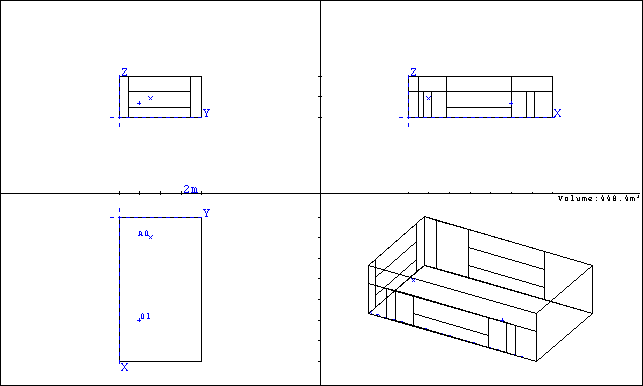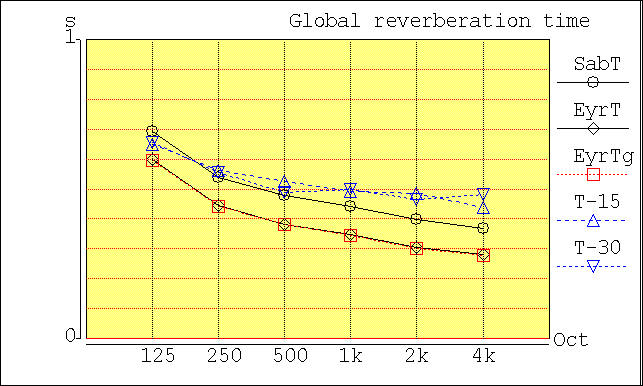Classroom Description
A classroom is a room designed for speech communication to a group of twenty to fourty students. Well designed classrooms usually have a highly absorbing ceiling, carpet glued to the floor to reduce chair and table noise, and some classrooms have additional absorption on the walls. The classroom used in this simulation has a high absorbing ceiling tile, carpet glued to the floor, walls of gypsum board on metal stud walls, absorbing panels placed on the rear wall, and several slate chalkboards on the wall. As a result of the absorbing ceiling and back wall, this room has a low reverberation time making it a good room for speech communication.Rooms designed for speech can also be good for listenting to delicate solo instruments like a guitar or cello but lack the required reverberation to enhance orchestral or organ music.
For these simulations a classroom with dimensions of 14 m x 8 m x 4 m high was created in CATT acoustics as shown in the figure below

Reverberation Time
The reverberation time (RT) in each of the six octave bands from 125 Hz to 4 kHz. The estimated RT computed using the Sabine equation (circles) and Eyring equation (diamonds) equations is plotted along with the estimated reverberation time computed using ray tracing from 4*T-15 and 2*T-30 (up and down triangles). T-15 is the computed time for the sound energy level to drop by 15 dB from th einitial energy level and T-30 is the time for the sound energy level to drop from -5 dB to -35 dB from the initial energy level.
As one can see, the reverberation time is well below 1 second in all six octave bands making the room very good for speech intelligibility.

Absorption
The absorption coefficients for the ceiling, wall, floor, panel, and chalkboards are shown in the table below. Data were taken from several well known texts including Beranek's "Concert and Opera Halls" and Mehta's "Architectural Acoustics"
| Absorption Coefficient | ||||||
| Material | 125 Hz | 250 Hz | 500 Hz | 1 kHz | 2 kHz | 4 kHz |
| Ceiling Tile | 0.60 | 085 | 0.95 | 0.98 | 0.98 | 0.98 |
| Carpet (Glued) | 0.02 | 0.04 | 0.08 | 0.20 | 0.35 | 0.40 |
| Wall panel absorbers | 0.40 | 0.50 | 0.60 | 0.60 | 0.60 | 0.60 |
| Gypsum Wall | 0.15 | 0.11 | 0.10 | 0.07 | 0.06 | 0.07 |
| Slate Chalkboard | 0.15 | 0.15 | 0.11 | 0.03 | 0.05 | 0.03 |
Impulse Response
The impulse response for the room as computed by CATT is shown in the figure below. Notice that there are few high amplitude reflections reaching the listener after 50 ms which means that speech intelligibility should be good.

|
These animations, auralizations, and visualizations are © 2006 by
Ralph T. Muehleisen and are licenced under a
Creative Commons Attribution-NonCommercial 2.5 License.
|